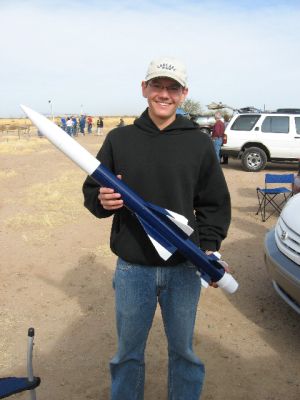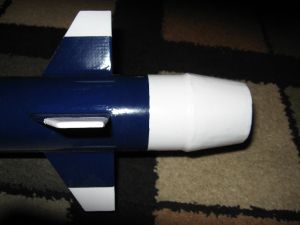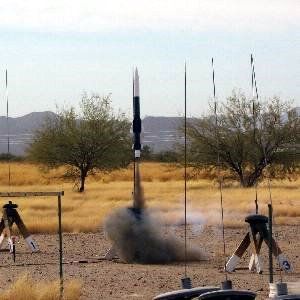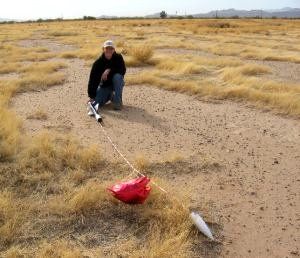| Construction Rating: | starstarstarstar_borderstar_border |
| Flight Rating: | starstarstar_borderstar_borderstar_border |
| Overall Rating: | starstarstarstar_borderstar_border |
| Diameter: | 2.60 inches |
| Manufacturer: | The Launch Pad  |
| Skill Level: | 3 |
| Style: | Scale |
Brief:
The Launch Pad Alarm is a single staged rocket that is modeled after an intercepting missile used by the U.S. government.
Construction:
Two body tubes came with this kit, but I wasn't too impressed with them. Instead of the solid tubes I was expecting, I got Estes type tubes instead, but they turned out okay and they really made this kit light. There are two sets of fins with one set very high up on the rocket, making it have very unique style. The fins themselves were balsa wood, so I decided to experiment on them, making them as strong as possible. The shock cord was about two feet long, so I replaced it with a 6-foot long 1/4" elastic. The nose cone was interesting. It was a decent nose cone, but the kit called for me to add on a paper tip to make it pointy. I eventually decided to not put it on. This kit came with 3/16" launch lugs but I upgraded them to 1/4" lugs.
A mylar parachute came with the kit and I was skeptical about the strength of it, but after its first flight I was satisfied with the material. It works okay, no problems so far.
The kit's instructions were decent, but they assumed you knew how to do many things, like what glue to use, where to put the launch lugs, and how to align the fins. Besides that, I thought that this was a fun and challenging build. The boat tail assembly was a little tricky, but the only real problem I had was the motor tube. I thought that I was set back way too far into the body tube, so I moved it forward about an inch so it was only 1/2" away from the bottom.
To strengthen the fins and the paper boat tail, I took drywall tape and cut out the shapes of the fins from it. I then put the tape on the fins and put about 4-5 layers of wood glue on them to strengthen and to fill in the bumps the tape made. The fins and the boattail turned out very strong, almost like plastic. The wood glue also took well to paint.
The only problem about the paper boat tail was that it was slightly too big for the tube, so it overlapped the body tube a little when I glued it in. I filled in the space made between the boat tail and the tube with wood glue. However, this made a bump that if I put the launch lugs on the rocket, this bump would get in the way of the launch rod. So I put pieces of balsa under the launch lugs to raise them over the bump.
Finishing:
Finishing was okay, but I had to try a little harder to get a rough enough surface on the wood glue coated fins to paint them. After that, everything went smoothly.
Construction Rating: 3 out of 5
Flight:
I have only had one flight so far, and it didn't go so well. Ever since the beginning, I thought that there wasn't enough nose weight to keep the rocket stable. When I launched it with an E11, it went sideways. It thought it was going to crash, but once the motor burned out, the fins made the rocket get lift and the rocket started to glide back upwards! I got very lucky that it didn't go straight down. I have recently found with RockSim that I need about 1.5 to 2 ounces of nose weight.
Recovery:
The kit said to do the Estes type of shock cord mount, but I thought it needed something stronger. I just epoxied the cord on the inside of the body tube (be careful not to epoxy where the nose cone shoulder needs to go).
The recovery after my first flight, even though it wasn't a great flight, was fine. I found no dents or scratches on the boat tail. Since I used the drywall/wood glue method on the boat tail, it made it much stronger.
Flight Rating: 2 out of 5
Summary:
This rocket definitely looks cool and it's fun but challenging trying to put together the boat tail. The only con about this kit is that it needed to upgrade a few things like the shock cord and the shock cord mount.
Overall Rating: 3 out of 5
Other Reviews
- The Launch Pad ALARM By Ted Phipps
The Launch Pad, a company specializing in military-style rockets and missiles, created this ‘scale’ kit of the Air Launched Anti-Radiation Missile (ALARM). The real ALARM is manufactured in Great Britain. Digging into the components, the 2.6" body tubes and plastic nose cone are Estes strength (might actually be Estes parts). There seems to be some complaints about the balsa in LP ...
 |
 |
Flights
Date | Flyer | Rocket | Altitude |
|---|---|---|---|
2009-05-09 | James Weaver | The Launch Pad ALARM | - |
2009-02-07 | James Weaver | The Launch Pad ALARM | - |
2007-01-20 | Sean Walker | The Launch Pad ALARM | - |
2006-07-30 | Joe Cacciatore | The Launch Pad ALARM | - |
2006-07-23 | Peter Stanley | The Launch Pad ALARM | - |
 |
 |
J.A. (June 1, 2001)
GS (February 14, 2007)
CB (March 2, 2007)
T.N. (March 17, 2007)
Sponsored Ads
 |
 |

















J.C. (April 1, 2001)